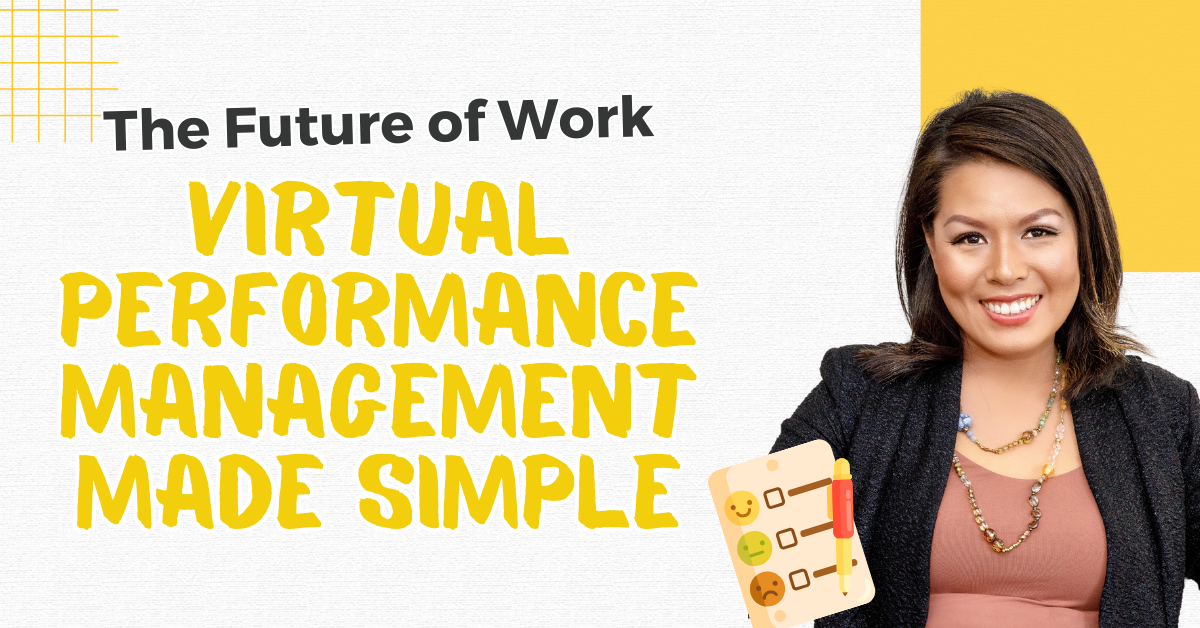The Future of Work: Virtual Performance Management Made Simple

In the evolving landscape of modern business, managing teams from afar has become the new norm. How well are we adapting our performance management practices to this virtual space?
So, you’ve got your virtual team? Perfect. How was the management experience?
Performance management, whether in a traditional office setting or a virtual environment, is the compass that guides the ship of productivity, efficiency, and employee development.
However, as we transition to remote work setups, it’s crucial to recognize that some gears might have shifted.
Traditional performance management models, built on face-to-face interactions and physical presence, no longer suffice in the age of digital connectivity.
In virtual environments, the dynamics change, and with them, the approaches to managing performance must evolve.
Communication can be trickier, accountability may waver, and the sense of camaraderie can be harder to foster. Yet, the potential for success is vast if we can harness the power of virtual performance management effectively.
In this article, we’ll explore practical virtual performance management tips you can implement to lead your virtual team to success.
Not sure which direction to steer your team and business? A map is what you need! Download our Buyers Agent Growth Map and get your property business properly charted to success!
Five Virtual Performance Management Tips for Buyers Agents

Loosen up! Be friends with your team
When it comes to virtual team management, one of the most valuable tips you can embrace is to loosen up and build a friendly rapport with your team members.
It might sound counterintuitive to some who believe that professionalism means keeping a strict line between work and personal relationships.
However, in the virtual realm, it’s often those personal connections that can make all the difference.
The thing is, in a physical office, you can easily stroll over to your colleague’s desk for a quick chat or catch up during lunch breaks. These casual interactions happen organically, creating a sense of camaraderie that often goes beyond work-related discussions.
But in the virtual world, these spontaneous moments are rarer, and that’s where the intention to befriend your team comes into play.
When you are “friends” with your team members, communication becomes more open and transparent. People are more likely to express their ideas, concerns, and feedback in a relaxed and trusting environment.
And did you know that a friendly atmosphere can boost employee morale and engagement? Happy team members tend to be more productive and motivated to do their best work.
Remember, the goal isn’t to become best friends with your team but to create a welcoming and supportive virtual environment where everyone feels comfortable and motivated to work together.
So, go ahead, loosen up, and be friends with your virtual team – it’s a win-win strategy for effective remote team management.
Set clear goals and performance expectations with specific KPIs

Just like in the physical office setting, setting clear goals and performance expectations, with specific Key Performance Indicators (KPIs), is a fundamental step in ensuring your virtual team and the business are on the right track.
Without goals, it’s like you’re trying to hit a target blindfolded. It’s nearly impossible, right? The same goes for your virtual team.
Clear goals and performance expectations offer several critical advantages. First and foremost, they facilitate alignment by ensuring that your team’s efforts are in harmony with the organization’s overarching objectives, which, in turn, helps to sustain focus and motivation among team members.
These clear expectations foster accountability, as specific Key Performance Indicators (KPIs) establish a quantifiable yardstick for assessing performance. This accountability empowers team members to hold themselves responsible, while managers can provide more precise feedback grounded in objective data.
In addition, the benefits extend to efficiency, as clarity dispels confusion. When team members possess a precise comprehension of their roles and performance expectations, they can work more efficiently.
Last but not least, well-defined goals and KPIs can be powerful motivators, as they offer clear targets to strive for and a tangible sense of accomplishment upon reaching milestones. This, in turn, encourages sustained effort and commitment from your virtual team
How to Set Clear Goals and Performance Expectations
Now that we understand why clarity is vital, let’s explore how to put it into practice:
Collaborative Goal Setting: Involve your team in setting goals. When team members have a say in their objectives, they’re more likely to feel ownership and commitment.
SMART Goals: Use the SMART criteria – Specific, Measurable, Achievable, Relevant, and Time-bound – to create goals that are clear and actionable. For example, instead of a vague goal like “Increase sales,” opt for “Increase monthly sales by 10% in Q4.”
Regular Communication: Maintain open channels of communication to discuss and refine goals as needed. Regular check-ins and updates help ensure everyone stays on the same page.
Performance Metrics: Define specific KPIs that align with each goal. For instance, if the goal is to improve customer satisfaction, the KPI could be “Maintain a customer satisfaction score of 90% or higher.”
Document Everything: Write down the goals, expectations, and KPIs. Share them with the team and keep them easily accessible for reference.
Feedback Loop: Establish a feedback process where team members can discuss their progress, challenges, and achievements. This helps course-correct if necessary and reinforces the importance of clarity.
By setting clear goals and performance expectations with specific KPIs, you provide your virtual team with a roadmap for success.
It’s like giving them the coordinates they need to navigate the journey effectively. With this tip in mind, you’ll find your team better equipped to meet and exceed expectations, no matter where they’re working from.
Talk with each other to establish strong communication and give constructive feedback

In the world of virtual team management, communication is like the heartbeat of your operations – it keeps everything flowing smoothly.
But it’s not just about chatting for the sake of it; it’s about fostering meaningful connections, sharing ideas, and providing constructive feedback.
Providing constructive feedback, on the other hand, is like a compass; it points you in the right direction for improvement. In a virtual team, this is an invaluable tool for individual and collective growth.
In our experience, constructive feedback and meetings often with the team invite continuous improvement towards growth, fuel our Champions and Heroes’ motivation to excel, and ignite better collaboration between each other.
Case Study: Gay’s Story
With almost 10 years in the virtual assistant industry, Gay has had various experiences working with different clients and agencies in the market.
In this interview, she shares about her journey with TGH, from the onboarding process, mission, vision, culture, and the training she underwent with us; and how it contributed to her personal progress and development.
She shares how the organisation at TGH from having a pod leader and both a Client Success Hero and Champion Success Hero helped her feel valued, seen, and appreciated, thus leveraging her quality of work and sense of self-worth.
Watch her full story here!
Explore software and tools for virtual performance management

Next tip is all about the right software and tools!
They not only make your life easier but also empower your team to perform at their best, no matter where they are in the world.
These tools help to streamline processes, making tasks like goal setting, tracking, and feedback easier to manage.
What we love about these tools is that they offer analytics and reporting features, giving you valuable insights into your team’s performance trends!
But it’s not really about micromanaging your team – it’s all about the collaborative work and success you and your team can do, bridging the gap created by physical distance.
You can use Asana, Trello, Monday.com, Microsoft Teams, ClickUp, or Slack.
Do your research about which CRM you’d like to use in your virtual team, considering your team’s size, goals, and budget.
Regardless of whichever tool you decide to use, the same principle applies: your team’s collaborative efforts are properly tracked, organised, and succeeded altogether.
Give recognitions and rewards

Let’s talk about the power of recognition and rewards.
Who doesn’t appreciate a pat on the back or a heartfelt “thank you” for a job well done, right?
When it comes to virtual team management, recognizing and rewarding your team members is especially important.
It’s not just about boosting morale; it’s about fostering a culture of appreciation and motivation in your team culture.
How to Give Recognition and Rewards Virtually
Unsure how to do it in a virtual setting? We understand!
You might not be sharing an office space, but there are many ways to give recognition and rewards to your virtual team.
Here are some suggestions we’ve got for you:
Praise in Public: Use team meetings or communication channels to publicly acknowledge accomplishments. It not only boosts the recipient’s morale but also inspires others. If you can, give them their “shining moments” on your business’ social media page!
Personalized Thank You Notes: Send personal messages expressing gratitude. Tailor them to the individual and specify what you appreciate about their work.
Virtual Awards: Create virtual awards or badges that team members can display on their profiles or email signatures. It adds a touch of fun to recognition.
Surprise Perks: Surprise your team with small tokens of appreciation, like e-gift cards, snacks, or branded merchandise, delivered to their doorsteps. Trust us, it’s an instant battery recharge!
Peer Recognition: Encourage team members to recognize each other’s contributions. Peer-to-peer recognition can be particularly meaningful.
Performance-Based Bonuses: Who wouldn’t want this? Try to implement performance-based bonuses or incentives to reward outstanding achievements.
Professional Development: Offer opportunities for professional development or additional responsibilities as a form of recognition.
By incorporating recognition and rewards into your virtual team management strategy, you create a more vibrant and motivated team.
Remember to celebrate wins, show your appreciation, and watch your virtual team flourish with enthusiasm and dedication!
Charting Your Course to Virtual Team Success

So, there you go, virtual team captains!
We’ve covered some fantastic tips that can turn the sometimes turbulent waters of virtual team management into a smooth sailing adventure.
From befriending your team to setting clear goals, embracing tools, fostering communication, and recognizing achievements, you’ve got the key ingredients to create a winning formula.
But wait, if you’re still feeling a bit lost in maneuvering your virtual ship, fear not! We’ve got something special just for you. 🎉
Introducing the Buyers Agency Growth Map—your treasure map to navigating the virtual team seas.
This free guide will help you plot a course to success, helping you to navigate your buyers agency business, and arming you with the right business strategy for growth.
Grab your free copy of the Buyers Agency Growth Map today and set sail towards smoother seas and greater success with your virtual team. The adventure awaits!
Note: Portions of this article were generated with the assistance of AI.
I am text block. Click edit button to change this text. Lorem ipsum dolor sit amet, consectetur adipiscing elit. Ut elit tellus, luctus nec ullamcorper mattis, pulvinar dapibus leo.




















